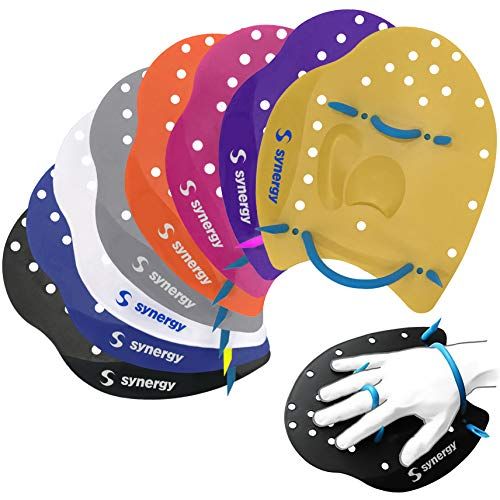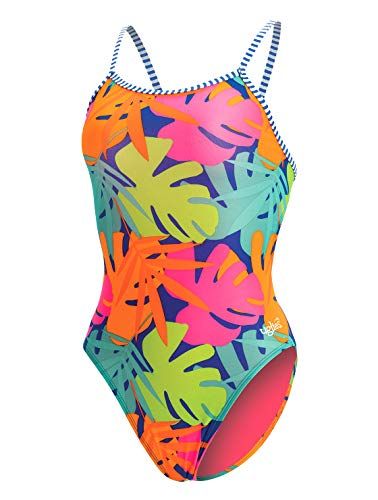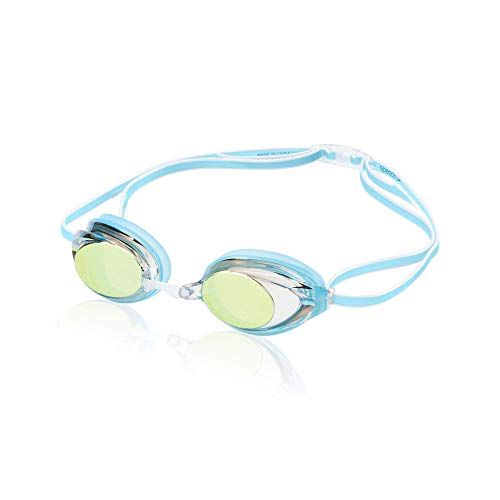How Many Calories Does Easy Swimming Burn
Amazing news for anyone who wants a killer cardio sesh but literally cringes at the thought of running: Swimming burns calories like crazy.
Seriously, go ahead and give yourself full permission to trade your running sneaks for a Speedo and find yourself a pool, because pulling yourself through the water is a helluva workout.
"Although swimming sometimes seems relatively hard and scary, it's one of the best cardiovascular workouts anyone of any age can do," says Life Time Athletic Senior Swim Coach Kris Gagne, who is registered and certified with USA Swimming and the American Swimming Coaches Association.
As you continually use just about every muscle you have to move your bod from one end of the pool to the other, "the aerobic work helps strengthen the heart muscle itself, making it more efficient at pumping blood throughout your body," Gagne says.
Oh, and if you hate how hard pounding pavement is on your knees, low-impact swimming (which puts pretty much no pressure on your bones and joints) make it easy to burn loads of calories without stressing out your system. "The water supports 90 percent of your body," Gagne explains.
Of course, just how many benefits you reap from taking your workouts into the water depends on a few ~key~ factors. Here's what to know about how many calories you can burn swimming—and how to torch as many as possible.
First, let's review the major benefits of swimming, shall we?
If you're not sold on the idea of donning a pair of goggles, allow me to remind you of all of swimming's pretty spectacular benefits.
1. It's a great cardio exercise that helps prevent heart disease.
I said it once and I'll say it again: Swimming is a great form of cardio, since you're challenging your heart and lungs to pump oxygen-containing blood throughout your system to keep you moving. You're basically always going to be out of breath after a good session.
This content is imported from poll. You may be able to find the same content in another format, or you may be able to find more information, at their web site.
In the long run, a swimming habit makes a major difference: "Studies with the American Heart Association have found that just 30 minutes of swimming a day can reduce coronary heart disease in women by 30 to 40 percent," says Gagne. Impressed.
2. Swimming tones your muscles and builds strength.
Because you have to overcome the resistance of the water when you swim, every stroke you take helps to build strength in your muscles—no weightlifting or traditional gym moves necessary, says Gagne.
So, in addition to reaping major cardiovascular benefits, you'll also sculpt your muscles, too.
3. Swimming literally works your entire body.
Another advantage swimming has over running? Moving your body through the water requires all of your major muscle groups—from your arms to your legs to your core—to get working, Gagne says.
Plus, by incorporating different swimming strokes—like breaststroke, backstroke, butterfly, sidestroke, and freestyle—you can work all of your muscles in different ways within a single workout, he adds.
Sound good? Here's how many calories you burn swimming.
While swimming is generally a pretty darn impressive calorie-burner, just how many you torch depends on several factors, including your weight, intensity, and which stroke you're doing.
Generally, Harvard Medical School estimates that in 30 minutes of recreational swimming:
- a 125-pound woman will burn about 180 calories
- a 155-pound woman will burn about 223 calories
- and a 185-pound woman will burn about 266 calories
However, if you turn up the heat and vigorously swim laps for 30 minutes, your calorie-burn increases. In this case,
- a 125-pound woman will burn about 300 calories
- a 155-pound woman will burn about 372 calories
- and a 185-pound woman will burn about 444 calories
The stroke you select also has a major impact on how many calories you torch. While a 155-pound woman burns about 372 calories in 30 minutes of swimming breaststroke, for example, she'll burn closer to 409 calories in 30 minutes of butterfly.
So, do you burn more calories swimming than you do running or bicycling?
Fun fact for all of you swim skeptics out there: You can totally burn as many (if not more) calories in the pool than you can on the bike or tread, as long as you put in the effort.
If you run at a 10-minute mile pace, for example, you burn about as many calories in 30 minutes on the tread or pavement as you would in the pool, says Harvard Medical School. However, if your pace lands closer to 11-plus minutes per mile, you'll burn more calories in the pool.
It's a similar story when it comes to swimming and bicycling. Spin those wheels at a moderate pace for 30 minutes on the stationary bike, and a 155-pound woman burns about 260 calories. (That's almost 100 fewer calories than 30 minutes of vigorous laps.) Kick up the spinning intensity to an all-out effort, though, and that same woman burns about 391 calories in 30 minutes, rivaling 30 minutes of butterfly in the pool (409 calories).
Let's break down the factors that affect how many calories you burn swimming.
Remember, the four biggest factors that influence the calorie-torching power of your pool workout are: your body weight, what swimming stroke you use, how hard you work (intensity), and how long you swim for (duration).
Of course, intensity and duration are pretty obvious. The longer and harder you swim for, the more calories you burn, Gagne says.
Prefer to keep your workouts on land? Try this 20-minute full-body sesh:
Body weight then factors in because the more weight you have, the more effort you'll have to expend to move yourself through the water. Plus, a larger body size means you have more surface area in the water, which then means you'll face greater resistance and need to work harder to continue moving.
Then comes the stroke you pick. Certain strokes are more technical and expend more energy than others, explains Gagne. Since butterfly involves sweeping both arms up out of the water and straight out in front of you at once (while performing a difficult dolphin kick), it's much more exhausting than breaststroke, in which you can leisurely frog kick and pull yourself through the water.
Want to burn more calories swimming? Here's how.
Lucky for you, you don't have to do lap after lap of butterfly (it's hard!) to torch more calories while swimming. Incorporate these three strategies the next time you dive in.
1. Create more resistance
"The more resistance you have in the water—whether using equipment or your own body—the more calories you'll burn," says Gagne. Steal a move from swimming pros and layer a slightly-loose swimsuit over your go-to Speedo (this is called a drag suit) or try out gear like hand paddles or fins.
2. Incorporate intervals
You know upping your swimming speed means more calories burned, but you don't have to sprint for 30 minutes straight to see big benefits.
Whether you're crunched for time or building up your stamina, Gagne suggests using interval training. For instance, swim as hard as you can for 30 seconds, then swim at a leisurely pace for 60 seconds, then repeat.
Just like HIIT on the tread, breaking up your pool workout this way allows you to maximize your effort and time while improving your performance and burning alllllll the calories.
3. Swim IMs
In an IM (a.k.a. individual medley), you swim each of the four primary strokes back-to-back to switch up the stimulus on your bod and, ultimately, turn up your burn big time, suggests Gagne.
Try this: Swim one lap of butterfly, then a lap of backstroke, then a lap of breaststroke, and finally a lap of freestyle. Use the strokes that feel easiest to you as recovery, or do a few laps of leisurely breaststroke or backstroke after your IM to recover before repeating.
The bottom line: How many calories you burn swimming depends on your weight, effort level, stroke, and workout time. However, you can generally expect to burn somewhere around 300 calories in 30 minutes of high-effort swimming.
Source: https://www.womenshealthmag.com/fitness/a32958151/calories-burned-swimming/






0 Response to "How Many Calories Does Easy Swimming Burn"
Post a Comment